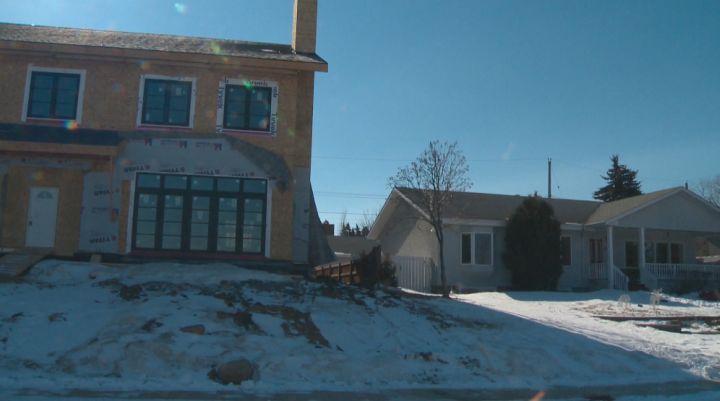EDMONTON – In an ever-growing city with an increasing population, the City of Edmonton is looking at ways to keep up with the changing urban environment. And that includes infill.

But while residential infill has already begun in many of the city’s older areas, not everyone is welcoming the concept with open arms.
“This house was approved without any variances to the bylaw,” Capilano resident Rob Dollevoet said of the house going up on the property next-door to his. “If they would have followed all the rules, we wouldn’t be complaining.”
Residential infill is the development of new housing in established neighbourhoods. This new housing may include secondary suites, garage suites, duplexes, semi-detached and detached houses, row houses, apartments, and other residential and mixed-use buildings.
Dollevoet says he’s not against the concept of infill, but he has some concerns with the size of the home being constructed next-door. The house towers over many of the original homes in the area.
But when Dollevoet and several other nearby residents brought their concerns forward to the city’s Subdivision & Development Appeal Board, they were told they were too late.
“There are 23 neighbours that went there, but under jurisdictional law we were not able to present our case because the 14-day development permit had already expired.”
So on Saturday, Dollevoet and his neighbours attended a public consultation meeting on infill in Edmonton. As part of the city’s Infill Action Collaborative, officials are hoping to get the public’s input as they work on developing draft recommendations for infill strategies.
“This project really is about working together to find ways to support infill and to improve the way we do things and to continue to support vibrancy of the neighbourhoods,” said Lisa Larson, acting senior planner with the City of Edmonton.
Over the next 30 years, Edmonton’s population is expected to increase by 500,000 people. And the city says supporting new housing in mature neighbourhoods is key when it comes to finding homes for the growing population.
“We know that we cannot continue to only grow outward, that as the city ages that there’s a lot of opportunity to re-imagine the older parts of the city,” said Mayor Don Iveson. “Whether it’s the empty lands at Blatchford where we can build a new kind of community, or lot-by-lot in neighbourhoods near new LRT stations or major employment hubs, infill is critical.”
READ MORE: Edmonton welcomes a new form of infill housing: ‘skinny homes’
Iveson says how infill is approached will differ in each neighbourhood, but it is going to happen, and it will add to the overall revitalization of Edmonton’s older areas.
“It’s going to mean more density, but it’s also going to mean more children to keep schools open, more people to support local businesses, more tax base to sustain the infrastructure,” said Iveson.
“We see reinvestment in our housing stock, new people that can come in to support existing amenities to be part of the social fabric of those communities,” added Larson.
Dollevoet says he’s not against the change, but wants to make sure it’s done properly.
“There’s great examples of infill in mature neighbourhoods around this area,” he said. “There’s already rules and bylaws in place, and all that has to happen is development officers must enforce those rules. We wouldn’t have cases like this of bad infill.”
For more information on infill, visit the City of Edmonton’s website.
With files from Tom Vernon, Global News.



Comments